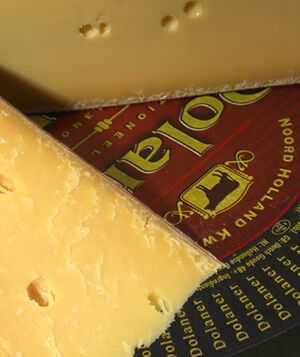Noord-Hollandse Gouda

- Description:
Noord-Hollandse Gouda is a BOB (Beschermde Oorsprongsbenaming) cheese of the Gouda type in the form of a cylinder or block with a weight of 2.5 to 30 kg. The specific characteristics are:
Flavour: aromatic, pleasant, melts in the mouth and is mild to strong depending on the age. Noord-Hollandse Gouda is less salty than other Gouda cheese
Cut: after cutting the cheese, the formation of eyes is visible, either evenly distributed or not throughout the section
Rind: the rind of the cheese is closed, smooth and shows no visible growth of mould; in particular its good preservation is one of the most striking characteristics
Consistency: the cheese lies "fully" in the mouth and, after some resistance is overcome and is very malleable; this typical characteristic has meant that it has long been denoted as a "soft dairy product"
- Geographical area:
Province of Noord-Holland. The specific characteristics of the cheese, namely the pleasant taste, the specific development of the dry rind and the special consistency, are the result of a combination of the composition of the milk in the Noord-Holland pasture area and the applied method of preparation of Noord-Hollandse Gouda. On account of its specific characteristics, it has a difference in quality for which buyers are prepared to pay a higher price (about 8%).
- History:
The preparation of Gouda cheese at dairy farms already dates back several centuries. This cheese has also been produced under factory conditions since about 1900. Noord-Hollandse Gouda is traditionally prepared under factory conditions according to the method described below, which is a particular adaption of the quality requirements for Gouda cheese which were laid down in the past on the basis of the 1911 Patent and Trade Mark Act for Cheese.
- Production:
Within 12 hours of delivery, the milk receives heat treatment for 30 seconds at 65°C and after standardization, the milk is pasteurised for at least 12 seconds at 72°C The milk is curdled with calfs’ or cattle rennet at a temperature of between 31°C and 34°C. Type A lactic acid (BD lactic acid), together with Leuconostoc cremoris, Lactobacillus lactis and Lactobacillus cremoris, are used for souring. The curds are treated and washed until the moisture and lactose content is such that a mild, non-acidic taste is obtained in the cheese (pH at 14 days > 5.25). The pressed curds are soaked in brine until a salt content of 3.3% on average and 3.6% maximum exists in the dry matter. After the cheese has matured for a minimum of 4 weeks and a maximum of 18 months at a temperature of at least 14°C, the characteristic properties of the product are obtained.
Reference: The European Commission
Find recipes that contain 'Noord-Hollandse Gouda'
#noordhollandsegouda #cheese #goudacheese #lacticacid #curds #dutchcheeses #lactose #cowsmilkcheeses #brine #dairyproducts #bob